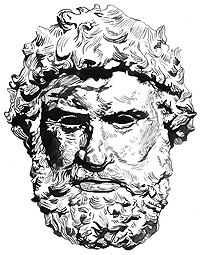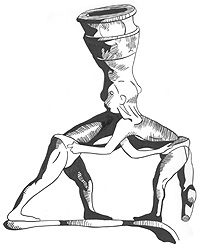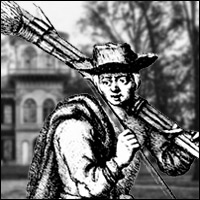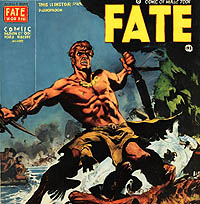Interestingly, most poof for the advantage of close over far combat comes from the modern period, after the advent of fire arms.
-Pike & Shot
The aquebesser and musketeer of the 1500s and 1600s were valuable and lethal troops that could not operate on the battlefield alone, other wise they would get run over by horsemen. A crucial maneuver of this age was the well-timed charge of horsemen. The army of Sweden, the best of the time, was very similar in size and operation to that of Alexander, a high functioning combined arms team.
During the late1600s Scottish highlanders, under Montrosse, won numerous battles against pike and musket formations using medieval swords and axes. Montross did appropriate the muskets. Keep in mind that once in a brawl with an empty musket, it is a closer range weapon than the pike, and hence more valuable of the two. This evolved into the use of the targe and claymore.
The response to this defeat by swordsmen of musket men operating in terrain limited the use of supporting pikemen, was the bayonet. The musket and bayonet would win the rematch at Culledun [circa 1704] and dominate the next 200 years of combat because it gave the Cromagnon advantage of distance and the Neanderthal advantage of close combat, to the same man, vested in the use of the same tool. A musket and bayonet, used like a pugil stick, is better than the targe and shield and more versatile in mass battle.
…
-Arrow & Club
Interestingly, in North America, in the Eastern Woodlands, at the time of first contact, the Iroquois were dominating warfare with wooden shields and war clubs and stone axes. This despite the presence of bows so powerful, owned by every warrior, that according to Captain John Smith in 1609, could fire through an oaken targe, and achieved greater penetration than a musket.
At about the time of the rise of the Iroquois, the most powerful and third most effective military force in America, was mustered by Hernan de Sota, who was the bloodiest handed man in human history. His force was based on his service with the Peruvian expedition.
Of 600 men:
240 were horsemen with swords
200 were swordsmen with shields and other close armed types like sailors and dog handlers
60 were halbredeers
100 were armed with cross bows or guns
This army of extermination that spent 4 years wiping out entire civilizations and warrior nations in the early 1540s, valued close combat over all else, most importantly trampling with horses and capturing with dogs. This preference was built in Spanish success over the previous 20 years in Mexico and Peru, in which small groups of sword and shield men with a handful of horse men and gunmen, defeated vast armies of javelin throwing warriors.
Indeed, the use of the throwing stick was so prominent and ineffective in Mexican warfare that paleo-anthropologists that study early missile weapons have christened this universal weapon of hunt and war according to the Aztec name, atlatl. No weapon lost an asymmetrical war so total as did the atlatl.
The men that fought Soto in the upper Mississippi did better, building forts and fighting to the death and attacking Soto and his men within their barracks at night, killing half of his force over time.
…
-Musket & Hatchet
Once the Eastern Woodland Indians acquired the gun they re- worked gun fighting war doctrine and made their primary weapon of war, the hatchet, into their close overrun weapon, used to “knock in the head.” Just as the ancient Greeks mostly used the sword for executing surrendering men and cutting down fleeing men, so the Indians used the hatchet.
“Taking up the hatchet,” was the term for war among the gunmen that imparted stone age hunting tactics to European and American soldiers. U.S. Army Rangers, Vietnam LRRPS, Navy SEAL Snipers and German Storm Troopers of later ages trace their war fighting directly to lessons learned with the musket, long rifle, hatchet and knife in the forests of North America in the late 1600s and 1700s.
Taking up the hatchet expresses the close combat ethic of tribal, which is to say genocidal, warfare.
…
-Column & Line
The black powder era of European warfare relied on deployed lines of musket and bayonet soldiers who formed into a giant shotgun, firing in volleys with damaging and inaccurate guns. The bayonets prevented horsemen from charging from the front. Canon were used to kill from a distance. Horse men were used to:
-scout
-screen, meaning they rode back and fourth in front of the army to obscure its order of battle and were sometimes targeted by canon, hitting horse and rider making a terrible mess
-flanking, protecting and menacing the flanks of the lineal infantry formations
-pursuit of a broken army was the terminal purpose of the horsemen, who were noblemen and made excellent Military Police for rounding up the conscript slave soldiers who ran away.
Class hatred for the soldier and the fact that he was likely to desert whenever the cavalry were detailed elsewhere along a line of march, encouraged the maximum expenditure of life. He was to be dressed up, marched around and shot.
The grenadier, a close fighter, who was larger and worked within stone throwing distance at first to hurl bombs, but was eventually just grouped in companies of big men, were employed as shock troops and as pressmen, to abduct normal size men for service as ordinary soldiers. They also acted as MPs.
During this period, from 1700 to 1815, two military organizations totally dominated their area of operations and did not lose even fights with the foe except by folly:
-The French Revolutionary Army, under Napoleon and others, which attacked in a column instead of a line, taking damage as they came to bayonet range and then broke the enemy line. This was not always the way, but was the French doctrine most feared by foes with less committed soldiers.
-The British Navy, which had poorer sailing ships then the enemy nations, with Dutch, French and Spanish building better ships. However, under Horatio Nelson, the British Navy swept all before it by a commitment to getting close, by going right in, just like medieval armed Barbary pirates of the time took merchant ships that had more guns, by getting close. And, in the end, in 1804, the infant U.S. Navy and marine corp would defeat these African nations by sailing their ships as close as possible, even at risk of running aground, and of fighting on foot aggressively against superior forces.
…
-‘To the Knife’
War to the knife was a tribal term in North America representing a war to exterminate, to get belly to belly, cut throats and take scalps rather than prisoners. This ethos was shared by the frontiersmen, including James Bowie, who developed big fighting knives. Some of the most effective horsemen in history were Confederate raiders in the 1860s who rode up to a man and shot him at point blank with pistol and carried Bowie knives for closer work.
…
-Spear, Asagi & Bayonet
In Africa, in the 1800s, the most feared tribe was the Zulus. This Bantu tribe came to prominence due to the psychopathic invention of the asagi by Shaka. Bantus, since 500 B.C. had been using iron hand weapons to exterminate the cappoid folk who had previously dominated most of the continent. These San Bush men, used bows and arrows and ruled most of Africa for 40,000 years. In a mere 1500 years the Bantu had all but exterminated them at closer range.
Bantu war culture had become distance oriented when fighting each other and not hunting down the San, Like ancient Greek pelatsts or Aztec warriors, much time would be spent ineffectively throwing light spears at a distance. Shaka changed this by inventing a short stabbing spear and the result was the death of millions of spear throwing men and their families.
The Zulus would famously wipe out a modern rifle armed regiment. However, after that victory, they knew they were doomed. Cestwato, the King, declared that the victory over the British soldiers was like being stabbed in the belly and the bloody draw at Rourke’s Drift was like having the blade twisted. What the Zulus discovered, is that a British soldier with an empty rifle and bayonet, was a match for two Zulus with asagi and shields at close range. The Zulus described these soldiers as fighting like lions, fighting close. The asagi and hide shield did no better than the claymore and targe against empty rifle and bayonet
Most combats, if even, will be won by the party willing to fight harder as he gets closer. In black powder warfare many retreats happened before bayonets were crossed, when men broke mentally and in spirit, third increased in the civil War when longer range mini-ball technology had oriented most men away from close work. We will take this concept to the present day with a survey of more recent advantages gained by the proximate aggressor.
I would note that the Military Edged Weapons Museum in Lancaster, PA has a vast collection of hundreds of improvised American military blade designs inspired by America operations against Asian foes in close jungle environments, innovations made by the most [relative] firepower heavy army in human history.











